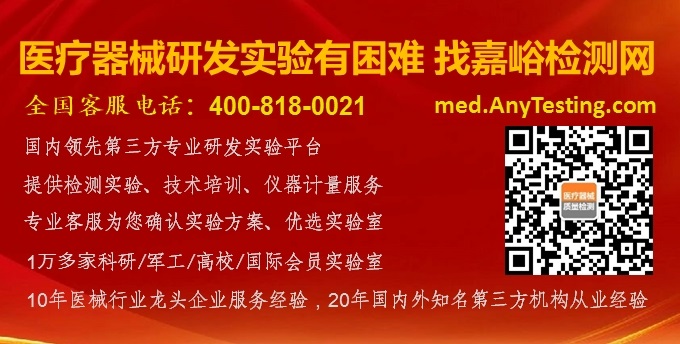您当前的位置:检测资讯 > 科研开发
嘉峪检测网 2021-12-13 15:48
医疗器械有效期验证是非临床验证中的必要的一项,其基本要求来自于ISO 13485(YY/T 0287)中的“文件控制”和“记录控制”:
......此期限应确保至少在组织所规定的医疗器械寿命期内,......
组织应保存记录的期限至少为组织所规定的或适用的法规要求所规定的医疗器械的寿命期, ......
对于有源医疗器械,尤其是设备类产品,预期使用寿命是制造商规定的预期保持产品安全和有效使用的时间段,根据风险管理的要求,制造商需要评估整个使用寿命内的风险控制措施的有效性。
产品的稳定性(可靠性,Stability / Reliability)将会影响产品的预期使用寿命。可靠性可以通过测试或分析来进行确认。其中测试方法通常包括环境加速老化试验,有源医疗器械使用期限注册技术审查指导原则(2019年第23号)中对此进行了说明。此外还有高加速寿命测试(HALT)和高加速压力筛选(HASS)等验证方法。可靠性的分析可以通过预期寿命分析来进行,考虑产品使用过程中的各种因素,NMPA的指导原则中也给出了相应的需要考虑的因素和要求。同时还可以考虑参考相关的标准(风险管理、电气安全、软件生命周期等)进行分析。
在预期寿命期间可能需要对产品进行维护、修理或升级。例如,对于医疗器械软件(SaMD)来说,制造商需要持续进行上市后警戒以确保其产品的安全性,如在预期使用寿命内提供安全更新。同时,由于软件所运行操作系统的更新,比如微软仅维护Win 10,Win 11,但不再维护Win 7之前的操作系统,此时,SaMD的制造商可能需要维护一个或两个主要的软件发布版本来持续提供预期使用寿命内的更新或补丁。(但更新时需注意NMPA软件指导原则中对于变更类型以及版本号的要求,重大变更、发布版本的变化需要进行许可事项变更注册。而在欧美法规体系下,可能只需要将这些变更进行记录或LTF以备查)
另外需要注意的是要区分预期使用寿命(Expected lifetime)和货架有效期/保质期(Shelf-life)。预期使用寿命是设备在无法达到预期用途之前的实际可持续使用时间,它的稳定性应该能够承受使用过程中性能的退化,例如重复使用过程中的清洁和消毒处理。货架有效期是指原包装中的医疗器械或附件在制造商规定的条件下保持其稳定性的期限,通常用于无菌包装,它的有效期在打开包装时,或制造商规定的保质期到期时结束。
有源医疗器械的有效期验证对于进口器械的制造商来说总是充满了太多的困惑,为了便于向老外们解释NMPA的要求,特地整理了一份英文版的概述性介绍,以便将来可以随时甩给他们,各位也有同样需求的同学拿走不谢。
1. Guidelines Summary
1.1 Overview
The NMPA guidelines on Active Medical Device Expected Lifetime (NMPA Guideline 2019-23) provide detailed guidance on analyzing and verifying the device's expected lifetime. When analyzing the potential degraded characteristics of the device, the manufacturer should perform risk analysis and risk control measures.
The guidelines provide two ways for device expected lifetime evaluation:
Set the pre-defined expected lifetime by assessment or practical experiences and verify it through one or more methods.
Determine the expected lifetime through one or more methods.
There are two approaches to evaluate the expected lifetime:
Verify the whole system (product) directly through real-time aging or accelerated aging tests, considering the device usage requirements of frequency, intensity, and environment.
Break down the system (product) into different subsystems/components, identify the critical and non-critical parts, and then define or determine the expected lifetime.
The following factors need to be considered during expected lifetime evaluation:
Critical component(s): the manufacturer should consider the safety of the critical component(s), i.e., dielectric strength, resistance, mechanical strength, or battery power... will these performances degrade over time, are the mechanical actions between the critical components could cause the degradation of the intended use, or if the production process will impact the critical components long-term performance...
Usage frequency and intensity: the frequency can be cycle times of use or continuous working period. The intensity can be under normal conditions or extreme conditions, for example normal power/max power. The intensity can also be verified by extreme stress tests.
Transport, storage, and use environment: when evaluating the expected lifetime, it is also needed to consider extreme transportation, storage, and environmental conditions. However, through risk analysis, if these conditions do not impact the S&P of the device, this factor can be non-essential.
Cleaning and disinfection: the cleaning and disinfection procedures, as well as chemical residues may cause the degradation of the device, which need to be considered and assessed.
Packaging and sterilization: the sterilization procedures and methods/parameters need to be considered for their impacts to the expected lifetime.
Maintenance: the repairment, maintenance, and replacement of the parts need to be considered for the impacts to the expected lifetime.
Commercial: the marketing strategy, and after-service can also be the consideration for defining the lifetime of the device.
1.2 Assessment methods
1.2.1 Prospective research on device/critical parts through accelerated aging test, and/or verified by real-time aging test.1
1.2.2 Experience data analysis on the new device and predicate/equivalent device, including sample product testing, clinical use, repair rate or records, complaints history, literature, etc.
1.2.3 The reliability assessment on device/critical parts, simulation tests, or other simulated calculation methods
[1] Aging test for active device, refer to GB/T 34986-2017 Methods for product accelerated testing, identical to IEC 62506: 2013. For non-active device/parts or sterile package, refer to ASTM F1980

来源:Advancing Regulatory Science


